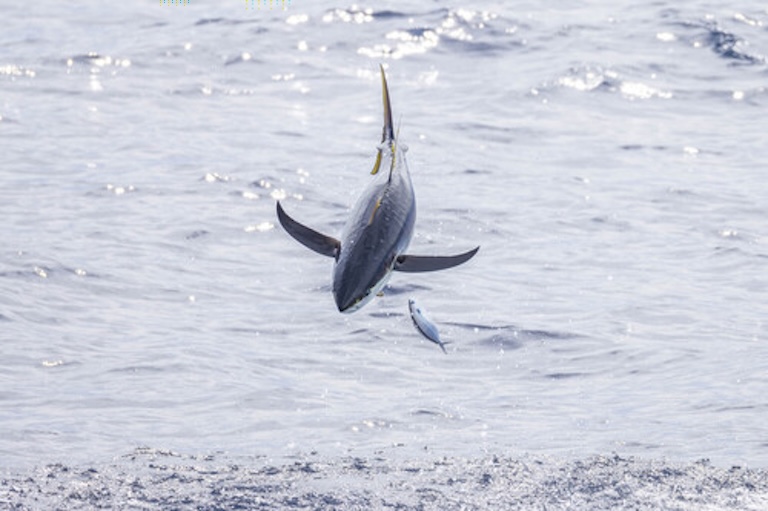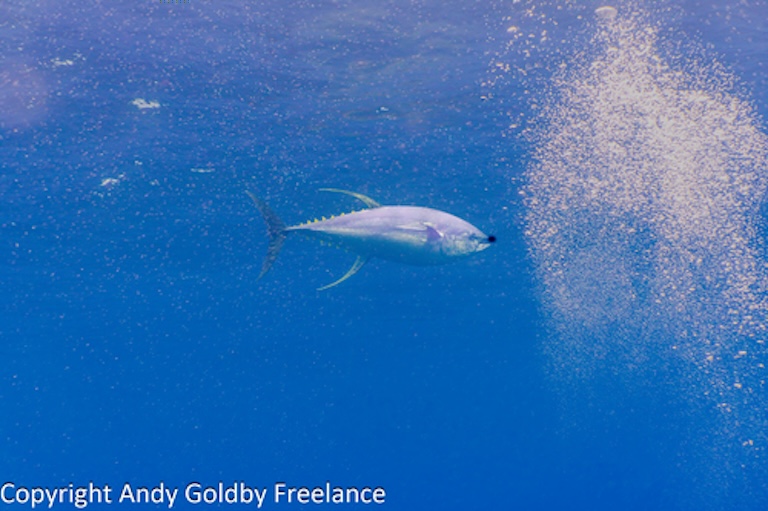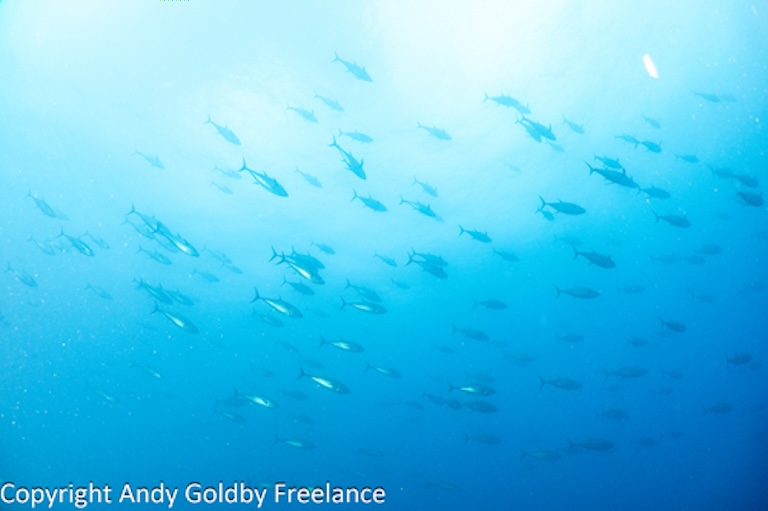Yellowfin Tuna Profile
Great Whites, tiger sharks and Krakens get all the attention when it comes to frightening ocean predators, and that’s because we typically don’t consider them in the context of tinned cat food and sashimi.
But as it happens, some of the most ferocious and high-performance hunters in the oceans are some of the most disrespected animals in the supermarket: Tuna.
And with more weight and predatory instincts than a full grown male African lion, the Yellow Fin Tuna is a great place to start changing this.

Yellowfin Tuna Facts Overview
| Habitat: | Pelagic marine |
| Location: | Pacific, Indian and Atlantic oceans, mostly in the upper 100m but can dive to 1km |
| Lifespan: | Up to around 8 years |
| Size: | 2.4 m (7 ft 10 in) |
| Weight: | 200 kg (440 lb) |
| Color: | Dark blue on the back, yellow to silver down to the belly |
| Diet: | Other fish, cephalopods, crustaceans |
| Predators: | Sharks, billfish and large marine mammals |
| Top Speed: | |
| No. of Species: | 1 |
| Conservation Status: | Least Concern |
Tuna are enormous and elegant predators in the mackerel family, and the yellowfin is one of the largest there is.
This warm-blooded, bullet of a fish is one of the fastest animals in water, and uses a unique hydraulic system to stay that way.
They’re also long-distance swimmers, and can be found all over the world.
Interesting Yellowfin Tuna Facts
1. They’re in the Mackerel Family
The Scombridae family, of which the Tunas are a member has around 15 genera of fish in it, and many of these are the most common and familiar food fishes for us humans. They’re found all over the world, and are almost all predatory fish, and perhaps the most familiar are the mackerel.
Mackerel are also the most prevalent, makimg up around 35 species of the 50 or so in the family, compared with around 15 species of tuna.
Tuna are one of the 35 genera, and they range in size quite substantially, with the lagest, the bluefin, being a true monster at around 700 kg. The Yellowfin is second only to this beast, and itself can reach up to around 200 kg, and as with all tuna, it’s very strong and very fast.

2. They’re warm-blooded (ish)
Very few bony fishes are able to regulate their body temperatures, which make the tuna quite exceptional in this regard.
Yellowfins and other tuna can raise their body temperatures to several degrees above the ambient temperature, which lies somewhere on the spectrum towards being “warm blooded”, though not to the extent of the mammals, for example.
Being hotter means things can run faster, and their metabolisms increase to meet their levels of activity. They cruise around at a decent speed, but in bursts, they’re one of the fastest fishes in the ocean.
3. They’re fast!
Tuna are so well suited to moving through water that the word “thunniform” has come to refer to any shape that’s rigid, streamlined and capable of torpedoing through water rapidly.
The Yellowfin is a large and muscular fish with a wide, crescent shaped tail and can generate and transfer tremendous energy through its body.
It’s known to be fast by fishermen, whose notoriously over-enthusiastic estimates have lent the fish the reputation of being a 75 mph bullet of a marine beast.
This is, of course, nonsense.
But the true speed of the yellowfin is still a bit of a mystery, and whatever it really is, it is very high.
There are several factors to consider when looking at speed in water, but one of the main ones is cavitation. When an object moves water out of the way by passing through it, water will fill that space again begind it. But if the object moves through the water faster than the water can refill the space, gases are pulled out of solution by the drop in pressure and form brief bubble pockets around the object. This is cavitation, and it’s very damaging to the delicate membranes of the fish’s fins.
This phenomenon puts a hard speed limit on marine life, at least for sustained movement, and that limit sits around 33 or 34 mph, or about 55 km/h.
One study from the ‘60s is about the only primary literature on the topic of speed on the Yellowfin and suggests a suspiciously high burst speed of 74 km/h, or about 46 mph. It’s possible that in a panic, these speeds could be attainable, but only very briefly and likely at some cost to the integrity of the animal’s fins.
For perspective, more recent studies into top speeds show the fastest fish in the ocean rarely reaching speeds of more than about 25 km/h or 16 mph. The infamous sailfish is a good example here – its maximum speed was no more than 50 mph: 35 mph, which it attained only briefly.
And the yellowfin is up there with the sailfish, making it a strong contender for fastest fish in the ocean.
One of the ways it reaches this speed is with a fantastic adaptation to its lymphatic system.
4. They’re Hydraulic
1 2The yellowfin’s torpedo shape, warm blood, powerful muscles, wide tail and retractable fins are all adaptations for speed, but they have one adaptation that nothing else does.
Tuna, like our military aircraft, have their own built-in fly-by-wire systems. Miniscule adjustments for direction and stability occur in the fins and tails, almost automatically, and they’re finely adjusted by way of a very unusual hydraulics system.
The fins themselves have special cavities at their bases, connected to the lymphatic system of the fish.
Special muscles squeeze on this flued to make the much-needed fine adjustments to the fins to keep the animal moving at speed and able to rapidly change direction. This system is so far unknown in any other vertebrates, and add to the tuna’s charisma as one of the most mesmerising and charismatic predators in the oceans.

5. Live fast, die young
All this racing around the ocean does take its toll. The fastest fish are often some of the shortest-lived, too, and the yellowfin, for all its grandeur, lives only to around 6 or 7 years old.
They grow fast, live fast, and die surprisingly young for such a large animal. But with with this exceptional speed, they do get a lot done.
6. They’re highly migratory
Yellowfins aren’t just fast, they have serious stamina. In the Pacific, they migrate from Japan to Australia, and African populations travel from the North of the continent all the way to the south.
In fact, some suggest that different populations migrate away from land, well into the open ocean between Africa and the Americas to meet populations from the opposite side of the Atlantic to breed with.
These are fast, powerful and long-range missiles, and despite being such a popular food source, their ability to travel still leaves a lot of mysteries to unfold around their behaviours.
7. They’re in decline
U fortunately, this globetrotting also brings with it some vulnerabilities. Stocks of fish are managed better by some countries than others, but long-range migrants cross between nations and this means their protection is no guaranteed.
When fishing from one country threatens the stock of fish in another, there emerges a sort of Tragedy of the Commons situation, whereby everyone is at a competitive disadvantage if they don’t over-exploit their stocks.
Of course, everyone is at a disadvantage anyway if they do, and recent surveys have assessed Atlantic fishing to be well above what’s sustainable, buy at last 35%.
In the Indian Ocean, this species is overfished, and mortality in juveniles and adults in the Pacific has seen a steady increase since the ‘70s.
Currently, while in decline, the species is still of least concern, perhaps due to its high pace of reproduction.
Still, there’s a lot more to a tuna than what you find in a can! 3
Yellowfin Tuna Fact-File Summary
Scientific Classification
| Kingdom: | Animalia |
| Phylum: | Chordata |
| Class: | Actinopterygii |
| Order: | Scombriformes |
| Family: | Scombridae |
| Genus: | Thunnus |
| Species Name: | Neothunnus |
Fact Sources & References
- Pavlov et al. (2017), “Hydraulic control of tuna fins: A role for the lymphatic system in vertebrate locomotion”, National Library of Medicine.
- (2017), “Stanford researchers discover biological hydraulic system in tuna fins
”, Stanford University. - IUCN REDLIST (2021), “Yellowfin Tuna”, IUCN REDLIST.
